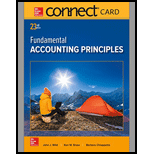
Introduction:
Segment Reporting:
The reporting policy of the company based on the business or operating segment or geographical coverage of the business is called segment reporting.
Business segment provides information related to individual products and services or group of products and services that are different from other business segments. Geographical segment provides information related to products or services within a particular economic environment that are different from other geographical area.
Segment reporting helps in better understanding of the company, better assessment of risks and returns and enables good comparability that helps in taking appropriate decisions by the management.
Requirement-1:
To identify:
The seven business segments operated by HP from its annual report for the fiscal year ended 2015.
Requirement-2a:
To identify:
The operating segment of HP that had the largest dollar amount of operating income during the fiscal year 2015.
Requirement-2b:
To identify:
The operating segment of HP that had the largest amount of assets during the fiscal year 2015.
Requirement-3a:
To compute:
The return on assets for each business segments for the fiscal year 2015 using the operating income and segment total assets.
Requirement-3b:
To discuss:
The highest return on assets of HP for the fiscal year ended 2015 to measure the profitability of the segment in relation to its total assets.
Want to see the full answer?
Check out a sample textbook solution
Chapter 7 Solutions
Connect Access Card for Fundamental Accounting Principles
- What are adjusting journal entries and why are they necessary? Meedarrow_forwardno ai What are adjusting journal entries and why are they necessary?arrow_forwardLawrence Industries plans to produce 30,000 units next period at a denominator activity of 45,000 direct labor hours. The direct labor wage rate is $16.00 per hour. The company's standards allow 2.2 yards of direct materials for each unit of product; the material costs $8.50 per yard. The company's budget includes a variable manufacturing overhead cost of $3.25 per direct labor hour and fixed manufacturing overhead of $270,000 per period. Using 45,000 direct labor hours as the denominator activity, compute the predetermined overhead rate and break it down into variable and fixed elements.arrow_forward

 AccountingAccountingISBN:9781337272094Author:WARREN, Carl S., Reeve, James M., Duchac, Jonathan E.Publisher:Cengage Learning,
AccountingAccountingISBN:9781337272094Author:WARREN, Carl S., Reeve, James M., Duchac, Jonathan E.Publisher:Cengage Learning, Accounting Information SystemsAccountingISBN:9781337619202Author:Hall, James A.Publisher:Cengage Learning,
Accounting Information SystemsAccountingISBN:9781337619202Author:Hall, James A.Publisher:Cengage Learning, Horngren's Cost Accounting: A Managerial Emphasis...AccountingISBN:9780134475585Author:Srikant M. Datar, Madhav V. RajanPublisher:PEARSON
Horngren's Cost Accounting: A Managerial Emphasis...AccountingISBN:9780134475585Author:Srikant M. Datar, Madhav V. RajanPublisher:PEARSON Intermediate AccountingAccountingISBN:9781259722660Author:J. David Spiceland, Mark W. Nelson, Wayne M ThomasPublisher:McGraw-Hill Education
Intermediate AccountingAccountingISBN:9781259722660Author:J. David Spiceland, Mark W. Nelson, Wayne M ThomasPublisher:McGraw-Hill Education Financial and Managerial AccountingAccountingISBN:9781259726705Author:John J Wild, Ken W. Shaw, Barbara Chiappetta Fundamental Accounting PrinciplesPublisher:McGraw-Hill Education
Financial and Managerial AccountingAccountingISBN:9781259726705Author:John J Wild, Ken W. Shaw, Barbara Chiappetta Fundamental Accounting PrinciplesPublisher:McGraw-Hill Education





